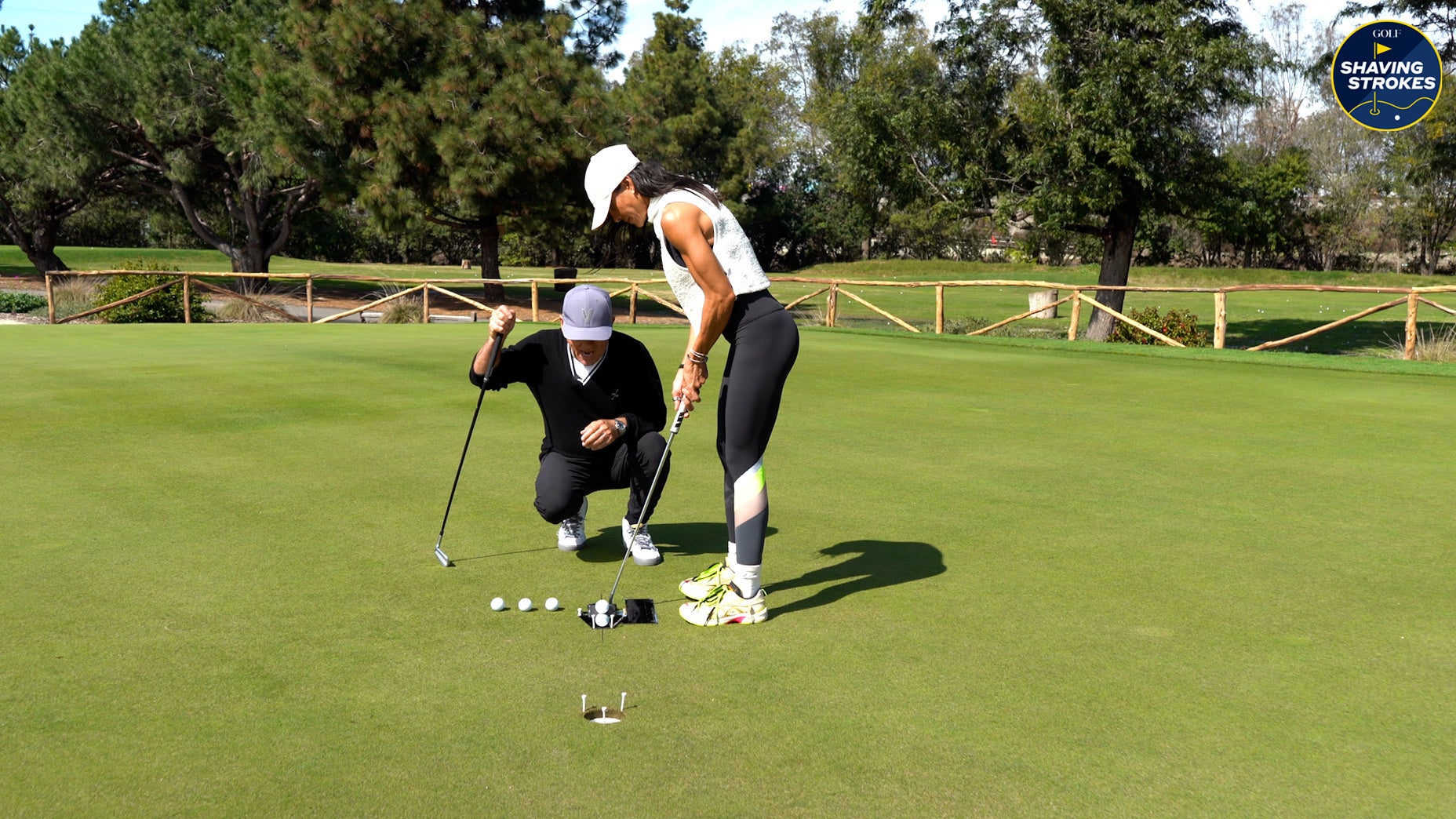Intimidating golf shot? These 11 tricks will help you avoid disaster

Don't let an intimidating shot defeat you before even taking your shot, says top teacher.
Images via David Woods
Welcome to Shaving Strokes, a GOLF.com series in which we’re sharing improvements, learnings and takeaways from amateur golfers just like you — including some of the speed bumps and challenges they faced along the way.
Over the past few months, I’ve played some incredible golf courses — which, admittedly, are probably much more difficult layouts than I’m typically used to.
From 5-star resort courses with lots of tricky bunkers and water, to major championship courses with narrow fairways and speedy, slopey greens, to layouts that test my shot-making skills from tee-to-green, I’m not sure I’ve hit a shot comfortably in quite awhile.
Sure, some of that comes from my own lack of confidence, knowing that, as a mid-handicapper, I don’t have the ability to hit the shot that’s required of me — like hitting a power draw off the tee to avoid rows of tree lines — but, really, it’s the course’s design that makes these shots so intimidating for me.
So how can a player overcome that internal doubt that often creeps into their head before a difficult shot? I asked GOLF Top 100 Teacher David Woods this very question, so he sent me 11 mental tricks that can restore self-belief and squash any intimidation. Check out his tips below.
Try these mental tips to overcome intimidation before a shot
Most of us have stood on the tee box of an absolutely breathtaking golf course with phenomenal views, leading us to whip out the phone and capture the scenery to share on social media — then reality sets in and it’s time to go into performance mode and hit a golf shot.
But with water on the right, sand on the left, a narrow fairway in front, and tons of slope all around, just taking a deep breath to overcome the intimidating shot isn’t enough.
“At a course like like Stone Eagle Golf Club in Palm Desert, Calif., it’s easy to get distracted by the spectacular surroundings,” says Woods. “But when it’s go time and you’ve got a difficult shot in front of you, having a solid pre-shot routine and a strong mental strategy is key.”
To clear your mind and build up confidence, Woods lists 11 different mental tricks that can help dial in your approach, leading to better results.
1. Identify your target
Oftentimes, I see two habits from amateur golfers. First, they either get up on the tee and just swing away, or, second, they’re so focused on swing mechanics that they lose track of their plan.
This is no way to confidently address your shot, though.
To overcome this, I suggest mitigating risk by aiming towards a large and forgiving area of the fairway — which might require you to use less club to avoid hazards or bunkers. Once you’ve got a general area you’d like to land it in, select a finite target like a branch on a tree or the right edge of the fairway bunker to aim for. The more detailed, the better.
2. Visualize the shot

Now that you’ve identified the target, stand behind the ball, lock in on that spot, and visualize the shape of the ball-flight. This gives you a clear and positive image in your mind prior to addressing the ball.
This is a common pre-shot routine for pros like Jason Day, who will often close his eyes for a moment to create a positive picture of what he’s about to do. This type of visualization does a couple of things.
First, it turns your focus to a very positive outcome, and, second, it takes some of the focus away from swing mechanics. We all know we play our best when we’re able to swing freely and with confidence — and this is best accomplished with minimal technical thoughts on the golf course.
3. Weigh risk vs. reward
Prior to taking any shot, you must be aware of your surroundings and consider the risk vs. the reward. Is it worth trying to reach the green on a par-5 in two if you’re forced to carry a hazard? If you decide it is, remember what the negative outcome could be: A double-bogey.
Every action has a reaction, so be sure you weigh the good with the bad while strategizing for an intimidating shot.
4. Understand the green speeds and slopes
Every course is different, so be mindful before your round to understand the variables around the green. Are they fast or slow? Are the greens grainy? Just like studying for a test, you need to put in the work and prepare in order to play your best.
5. Know where the trouble is

Every course has red light and green light shots, so be sure you know when to send it and when to be more conservative.
Trouble is more than just hazards like bunkers or water, though — which many amateurs sometimes forget — so take note of areas with possible loose impediments near trees, or, in general, where heavier rough might be.
6. Consider the weather conditions
For anyone who’s ever played in wind, you know how much havoc it can cause on the golf course. So take into account how the conditions might impact your golf shot, and what’s required of you as a player to execute what you visualize.
Do you need to hit a low stinger off the tee to avoid the wind? If so, commit to that club choice and go. Learning to flight down shots for windy days is a great opportunity to gain an advantage on other players.
7. Determine the elevation of the landing area vs. the hitting area
Many rangefinders have slope options, meaning they give you the yardage based off elevation — always use it. This gives you an advantage, allowing yourself to make the proper club choice.
For instance, if you carry your 7-iron 160 yards but have an elevated green that makes it a 170-yard shot, it’s important to know that, adapt your plan, and club up if necessary.
8. What’s your tee shot angle?
Part of what makes a golf shot so intimidating is seeing the hazards on either side of the hole while standing from the tee box. So if you see trouble on the right, tee off on that side of the tee box and swing away from the hazard.
Creating safer shot angles for yourself is one of the easiest mental tricks, and it can be done by just simply aiming away from any danger.
9. Be sure your alignment is correct

Is there anything worse than flushing a shot and immediately realizing it’s heading in the wrong direction? This is a common issue lots of amateurs experience — and it all comes down to improper alignment.
Part of a great pre-shot routine is aligning yourself the right way, so take your time and even pick an intermediate target if you need to.
10. Know your tendencies
You are who you are as a golfer, so recognize and accept that. Sure, you may hit that one incredible shot that surprises both you and your buddies once in a blue moon, but if you have doubt about something going through your routine, that should be a red flag.
So always play to your strengths and try to avoid shots during a round that you don’t feel like you can pull off. If you do happen to get into trouble, talk yourself out of attempting a “hero shot”, and, instead, just get back to the fairway and reduce the odds of a big number.
11. Execute
After using some (or all) of these mental tricks, it’s time to go execute the shot at hand. Sure, it may be intimidating, but you’ve done your due diligence and need to live with the results — whether they’re good, bad, or just OK.
Regardless of outcome, it’s imperative to always focus on the positive, which will help lead to better scores in the end.
Rapsodo Mobile Launch Monitor (MLM)
$249.99
View Product














